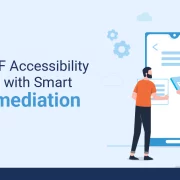
How to Leverage Technology to Improve Student eLearning Outcomes
Technology has impacted all aspects of our lives, and education is one of them. One of the advantages of technology in education is that it can bring real-world problems into the classroom for students to understand and solve. It can also create virtual and simulated environments in which students can learn by doing or exploring concepts without any adverse repercussions.
Over the years, schools have made efforts to incorporate real-world context in classroom teaching through field visits, lab experiments, etc. However, activity-based contextual learning has never been at the heart of an academic curriculum in the traditional classroom setting, primarily because of logistical constraints.
Table of Contents:
- Simulations and 3D models
- Teaching aids
- Collaboration tools
- Advanced research
- Interactive assessments
- Flexible learning
eLearning is a powerful means to address these constraints. Digital technologies such as videos, computer simulations, and electronic communication make learning fun, practical, engaging, and immersive. Interactive eLearning modules are emerging as a popular means to redefine education, enabling students to learn at their own pace, practice skills, and gain real-life perspectives.
Here’s how higher education institutions can leverage technology to improve student eLearning outcomes.
1. Simulations and 3D models
As students, we have all experienced how difficult it is to grasp certain concepts especially in subjects like Math and Science. Digital simulations and 3D models can improve students’ understanding of these concepts. Technology can give shape to abstract concepts, put them into context so students not only understand the concepts but also see first-hand how they can use them in real-life situations. For instance, when they learn about geometry, they can see, understand and experience that its use is not just restricted to mathematics but that it is also integral to various art forms. Know more, how does realistic simulation can enhance K-12 learning.
2. Teaching aids
Technology also provides a much-needed helping hand to teachers who find it difficult to explain certain things within the limits of the classroom. For instance, teaching the difference between grasslands, savanna, and a prairie. With technology, it is possible to add eLearning modules that take students to a virtual visit of these lands, allowing them to ‘see’ and identify the differences between these landforms, rather than memorizing from the textbook.
3. Collaboration tools
Communication is an integral aspect of any activity and more so of any educational activity. Students learn by doing, they also learn by interaction with the instructor and peers. Technology has helped to bridge communication gaps and ensure a smooth flow of knowledge.
Instructors can use collaboration tools to form communities where they can interact with students, assign projects, resolve doubts, etc. Today, as most of the learning is taking place in a remote environment, these collaboration tools help students to connect with their peers across geographies and learn together.
4. Advanced research
Incorporating technology in education helps to shift responsibility and control over learning from the teacher to the students. To improve the students’ eLearning outcomes, instructors can assign projects that require learners to research and build their case for a particular topic. Once the students have collated the information, they can present their research to the entire class. The advantages are two-fold: first, the students own their learning, and second, they advance their research skills and learn to incorporate information and knowledge in their projects.
5. Interactive assessments
There are various software available that allows instructors to assign assessments and receive responses in real-time. Besides, tracking, analysis, and reporting tools can be used to glean insights into each student’s progress, and also the effectiveness of each lesson. The analytical report also helps teachers understand what further efforts are required to achieve improved eLearning outcomes.
6. Flexible learning
eLearning modules allow students to learn at their own pace. In textbook-based learning, students are more likely to skip over a concept if it isn’t clear to them. However, missing one step in a ladder breaks the entire journey. Then there may be students who take more time to absorb a certain idea. With eLearning courses that are always available to them on digital devices, they can go through the lessons as many times as they want, taking time to thoroughly understand concepts. Technology is therefore a great leveler, allowing students to progress at their own pace and improve their eLearning outcomes. Check out how you can improve user engagements with eLearning interactive modules.
In conclusion
While technology cannot replace classroom learning, it has emerged as a much-needed supplement to improve learning outcomes. eLearning modules supplement traditional classrooms, making learning fun, immersive and engaging. Students can learn at their own pace and understand the relevance of various concepts in the real world. Teachers too can leverage technology to explain difficult concepts and improve students’ eLearning outcomes.
Need to know more about our Products & Services ? Drop us a note on marketing@hurix.com

Senior Vice President – Business Development
Over 25 years of experience in the edtech and workforce learning industry with strong skills in Business Development, Customer Relationship Management (CRM) and Strategy.























